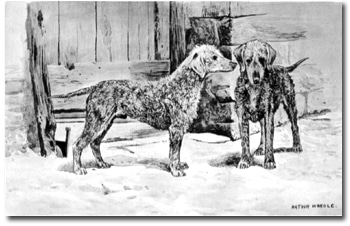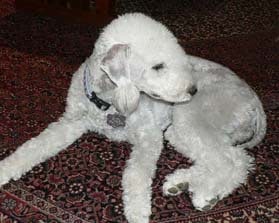Yes, the Bedlington may resemble a lamb, especially to children because of its soft hair, size, and overall shape. It also has a narrow head and the raciness of a Whippet with a pronounced arch over its loins. But aside from a distinctive appearance, of all the “purebred” terriers the Bedlington has the oldest non-broken pedigree going back to 1782. This notable dog was owned by Squire Trevelyan in the town of Netherwhitton located not far from the towns of Morpeth, Rothbury and Bedlington in northern England. Many people of different backgrounds owned them and not just the local gypsies as some publications state. So how did the Bedlington terrier come to be?
The early records of dogs in England give credence to a number of different breeds of terriers which were concentrated in the area known as the Rothbury forest in the county of Northumberland. All of these terriers were collectively known as Rothbury terriers. As employment opportunities increased because of the coal in the area, towns grew in size and drew families from southern England and even from other countries. Some of these people, such as those from Staffordshire, were skilled in nailmaking and of course the coal attracted the miners. It is reasonable to assume that as people migrated, they brought their dogs along with them for hunting, sport and companionship.
The word “terrier” refers to dogs that go to the earth for hunting. They are natural hunters, possessed with a proclivity to go after vermin and rodents. To determine which ones were best for those tasks, the men would arrange contests to ascertain those that excelled. Formal dog shows, as we know them, did not begin until the mid 1800’s, so the men cross-bred with other breeds of dogs to try to improve the terrier skills. Otterhounds may have been used for endurance and strength, Whippets for speed, Poodles for coat and to a much smaller degree it was even thought that a Bullterrier was thrown into the mix for feistiness. Since record keeping during the late 1700’s was sporadic, we may never know which dogs went into the Bedlington breed.
The men who wanted to improve upon the function of their terriers noticed that there was a certain variety of terrier that had the most desirable skills and attributes. These dogs were identified by a long muscular jaw, a narrow pointed head, a flatness of cheek, ribs that were flat and deep, ears that hung close to the side of the head, a liver- colored coat and other distinctive characteristics. Most had long legs. Some early “bedlingtons” had short legs and these became known as the Dandie Dinmont terrier whereas the longer legged ones eventually were named the Bedlington Terrier. Both, however, had similar roots and the long-legged terriers proved best at catching rabbits, rats, marten, badger, fox, polecat and since they were water dogs, they could easily work an otter. What their masters referred to as “game” might today be called aggressive. These early dogs were jealous of other dogs and rarely worked in pairs, either with their own kind or with others. This was the strain of terriers that Squire Trevelyan owned in 1782. And the characteristics of this strain eventually became a basic breed standard. No other terrier could compare to this specific terrier in stamina, courage, loyalty and determination.
It was 40 years later when Joseph Ainsley, a mason, purchased a dog named Peachum and bred him with a dog named Phoebe owned by Mr. Dixon. The result of that union was Piper who was sold to James Anderson of Rothbury Forest. Piper was a slender built dog about 15” high and 15 pounds in weight. He was liver colored with large ears hanging close to his head. In 1820, Mr. Howe of Alnwick visited a friend in the town of Bedlington and brought with him a terrier bitch also named Phoebe, which he left with Mr. Edward Coates of the vicarage. Phoebe belonged to Mr. Andrew Riddle, of Framlington but because she lived at the vicarage, she was known as Coates’s Phoebe. Her color was almost black and she had a light-colored tuft on top of her head. She was about 13” high and weighed 14 pounds. In 1825, she was mated to Anderson’s Piper and the result of this union was Ainsley’s Piper. The location of the dogs inspired Ainsley to confer on it the breed name of “Bedlington terrier”.
The Bedlingtons of today have come full circle in the competitive dog show world. They began their written existence based on their function as a good hunter. In the late 1800’s they were judged on their form or looks as compared to a written standard. Today, dog shows include conformation competition as well as competitions that showcase what the dogs were originally bred to do. In any case, the Bedlington terrier has evolved as a loving, playful, adaptable, and obedient companion.

